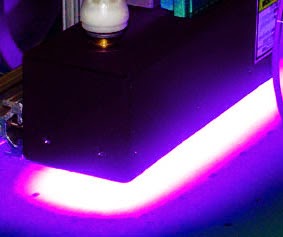
Exposure to UV light initiates the chemical reaction that causes the ingredients of a UV curable ink to bond together. Exposure in the curing unit doesn’t a completely cure the ink though. In fact, only about 90% of the chemical reaction is complete. This chemical reaction that the UV light initiates can continue and the chemical bonds continue to form. The phenomenon of the ink continuing to cure after printing is called post cure or dark cure.
After some UV inks are initially cured by exposure to UV light, they continue to cure. The general rule of thumb is that this post cure period for free radical UV inks lasts for 24 to 48 hours after printing. Inks companies now have published in their tech bulletins that this curing period may last longer than originally thought. How long? Some think that this post cure process can last for weeks. Factors affecting post cure include the printing environment, the intensity of the light and the substrate.
As the inks continue to post cure and more chemical bonds form, the ink becomes tougher and adhesion to the substrate becomes stronger. There are a couple of problems that can occur as the inks post cure. The first is that printed vinyl films can shrink. Another issue is that as the inks continue to cure, they become brittle and can crack. The same problems that digital printers are having today are some of the same problems that screen printers had when UV inks were first introduced.
So how can you determine whether the inks have cured properly? Digital printers can get an idea of how well the ink has cured by performing a simple tape test to check ink adhesion. In this test, burnish 3M’s #610 tape to the print and pull it from the substrate at a 90º angle. If the ink pulls from the substrate, you don’t have good adhesion and the inks most likely have not cured fully.
Another test that you can perform is a thumb nail scratch test. It’s not very scientific, but it’s a good way to tell if inks have cured. Just rub you fingernail against the printed surface. A fully cured ink will be hard as nails and will not scratch off.
Finally, your nose knows. If the ink continues to give off an odor, it hasn’t completed the post cure process. UV inks often smell when they are being processed because the byproducts of curing are partially volatile. Good ventilation is critical when you process UV inks, or the smell can get pretty objectionable.
When UV inks do not cure properly, the usual suspects that can cause the problems include the type of ink used, the thickness of the ink deposit, the type of lamps, the age of the lamps and the type of reflector. In the design of their equipment, manufacturers of UV curable inkjet systems take into consideration the ink chemistry, UV light wave length, intensity and amount of exposure to ensure that adequate curing takes place in all of the applicable print modes and with various substrates. Well-designed printer systems will prevent you from going outside the safety zone of the printer system. That way you cannot print so fast that there is not enough UV energy to properly cure the inks.


